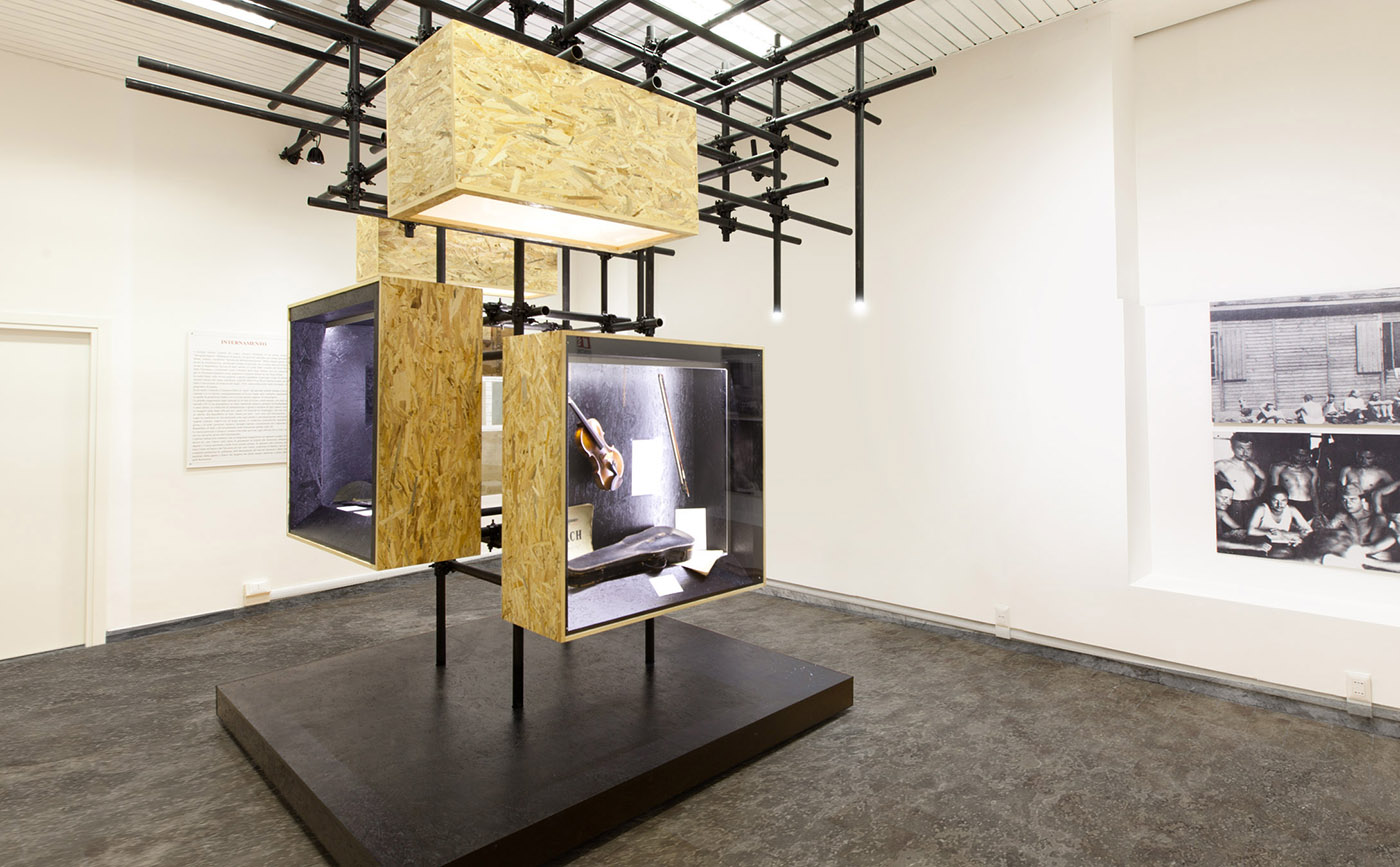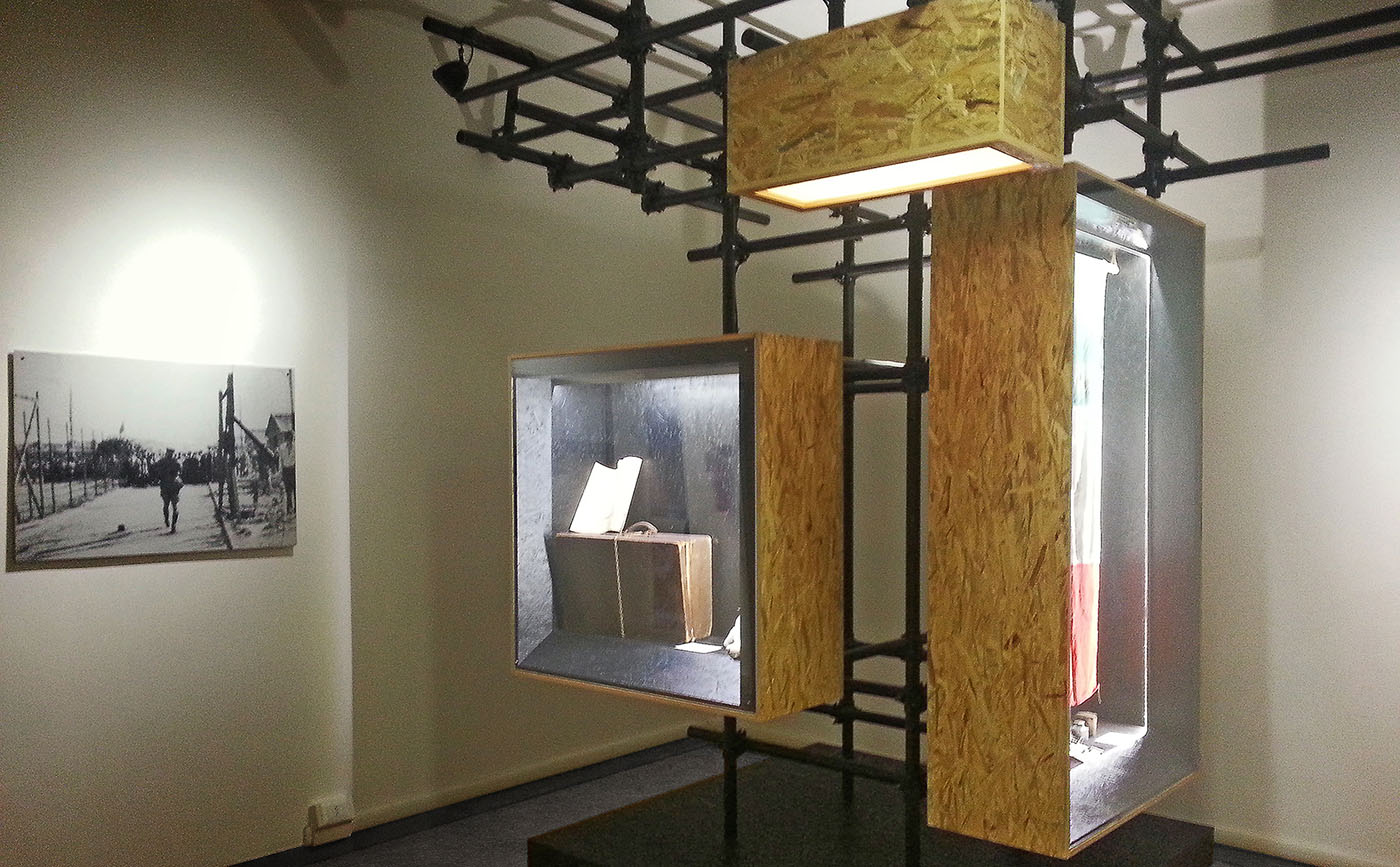Exhibition "Vite di IMI"
Commissioned by: ANRP
Location: Rome
Year: 2015
“The cold of a thousand pointed iron wires surrounded us all, snatched and mistreated by the wind. A few wooden board joined together to form a hut with a stove in the middle, with a damp and white tear of cast iron”… “Behind a deathly cold, or dead from cold. It’s the same thing.”
– Franco Mazzanti
The idea behind the “Vite di IMI” started with the study of many IMI’s personal experiences, who passed their testimony down through their stories and often through different art forms. Particularly from the latter, emerges the brutal and rough horror of the internment: the deprivation of liberty, the constriction in the camp, the prison labour, the struggles, the loss of their dignity, the death, in order to defend their choice of resistance: a “No!” paid in most cases with the highest price.
This sentence, extrapolated from a poem of Franco Mazzanti, an IMI deported to a concentration camp, summarizes some of the most popular images to be found among the artistic expressions and artworks we inherited, but also among the memories of the survivors. Iron is seen as a material but also as a feeling of deafness, sharp cold, death. The wood of the shacks is seen as a useless shelter, the silence and the resignation of dying souls. Therefore, the exhibition spaces have been set up in order to transmit the echoes of those sensations. This purpose guided the creation and design of the exhibition structure and its integration with the designated areas in order for them to become strong and distinctive elements, which can lead to the right interpretation of this exhibition path. Every room has to be a representational composition itself, with its disequilibrium between light and matter capable to transmit its message simply through the visual and spatial experience.
The architecture of this exhibit is based on the reiteration of the same structural paradigm, which supports the purpose of the exhibition tour, but at the same time provided with a strong expressivity. Its strong characterisation allows it to be capable of structuring this path and mark all the different areas of the exhibit. The sculpture is realised by assembling many black varnished iron pipes, with an inverted weight logic, created by gradually increasing the number of pipes on the upper part of the sculpture. The decorative elements in OSB wood hold on to the sculpture, hiding the few vertical elements and creating the illusion of a heavy metal twist hanging on fluctuating boxes a few centimetres from the floor. The more the structure moves away from the floor, the more the weave increases in size; pipes are more numerous and longer, until reaching a considerable size at the ceiling level. As a result, lines seem to gather all the objects, walls, lights and the visitors’ attention, and lead them to the main structural and figurative core of the element itself. It applies a strong dynamic power to the space, unifying it and condensing it into the exhibition paradigm, where the main contents of the show or the tour functions are concentrated. The lightness of the composition contrasts with the weight of the matter. The black, sharp, cold iron; the rough, unpolished, worn wood. This is all crystallised in a freeze-frame, just a moment before the inevitable collapse, whose effects the observers can imagine, and whose noise the observers can already hear.
One of the main purposes of this exhibit is to reach and get young people involved, many of whom do not know about IMI’s history. To do so, the analysis of contemporary trends, which influence the exhibition methods in the most important and innovative international museums, has been crucial. Digital technology, for instance, plays an important role in the mediation between the object and the visitor. The possibility to view or listen to the contents using your phone or tablet, allows you to acquire information in an easier, funnier and interactive way, and gives you the opportunity to filter it through your personal knowledge, studying it in depth, if needed.
The visitors of the exhibition “Vite di IMI” will have the opportunity to check an interactive map of all different rooms on their phones, accessing a panoramic picture of each room. In this picture, through which the visitor can navigate on his touchscreen, the various components of the room will be highlighted. To each of them a few description sheets will be assigned, accessible by clicking on the item itself. The map becomes a guide through this path and a support tool to the discovery of the exhibition contents, inviting us to discover every little area of the rooms in an interactive and personal way.
During the exhibit, a few screens will revolve around the exhibit structure. Multimedia contents and digitalised material will be played, like photographs, documents, movies, etc. Videos will contain narration of letter extracts, diaries and other IMI’s testimonies.
In the rooms, some wall panels will display QR codes readable through your phone, which will show the contents of the screens and further audio-video material, maximizing the possibility of studying in depth the content shown during the tour.
The use of a dynamic and interactive system will ease the learning process based on the possibility to control the information flow in a simple and personalised way, using modern communication tools, now part of our everyday life.





